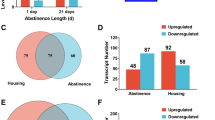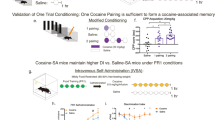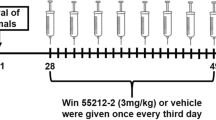Abstract
Alterations in gene expression within the neural networks of prefrontal cortex (PFC) and hippocampus (HPC) are known to contribute to behavioural phenotypes associated with drug intake. However, the functional consequences of regulated expression patterns of Fosb and Crem (cAMP response element modulator) in both brain regions in response to volitional intake of cocaine in social environment is yet to be explored. Here, we first exposed young adult mice to cocaine (300 mg/L) and water concurrently for 30 days in the IntelliCage to investigate consumption preference, and subsequently for 28 days during which persistent motivated drug seeking behaviours were examined. Thereafter, locomotor activity and memory performance of the mice were assessed. DNA methylation status in the promoters of Fosb and Crem genes were also evaluated. We show that mice that had extended access to cocaine exhibited motivational deficit and demonstrated decreased locomotor activity and intact recognition memory. These changes were accompanied by hypomethylation or hypermethylation in the promoters of Fosb and Crem genes in the PFC and HPC of the cocaine-experienced mice, respectively. Together, these findings correlate the molecular changes to behavioural effects of the treatment and further suggests a possible activation of prefrontal cortical networks by social interaction episodes in the IntelliCage which possibly enhanced behavioural control that dampens mice sensitivity to cocaine rewards. Furthermore, our data delineate the molecular response of Crem and Fosb to oral cocaine in group-housed mice and demonstrates differential regulation of activities within the substrate brain regions studied.






Similar content being viewed by others
References
Abboussi O, Said N, Fifel K, Lakehayli S, Tazi A, El Ganouni S (2016) Behavioral effects of D3 receptor inhibition and 5-HT4 receptor activation on animals undergoing chronic cannabinoid exposure during adolescence. Metab Brain Dis 31:321–327
Allen A, Cooper D, Kiser W, Cottreli R (1981) The cocaine diastereoisomers. J Forensic Sci 26:12–26
Anier K, Malinovskaja K, Aonurm-Helm A, Zharkovsky A, Kalda A (2010) DNA methylation regulates cocaine-induced behavioral sensitization in mice. Neuropsychopharmacology 35:2450–2461
Bell HC, McCaffrey DR, Forgie ML, Kolb B, Pellis SM (2009) The role of the medial prefrontal cortex in the play fighting of rats. Behav Neurosci 123:1158
Broadbent NJ, Gaskin S, Squire LR, Clark RE (2010) Object recognition memory and the rodent hippocampus. Learn Mem 17:5–11
Carlezon WA, Thome J, Olson VG, Lane-Ladd SB, Brodkin ES, Hiroi N, Duman RS, Neve RL, Nestler EJ (1998) Regulation of cocaine reward by CREB. Science 282:2272–2275
De Cesare D, Fimia GM, Sassone-Corsi P (1999) Signaling routes to CREM and CREB: plasticity in transcriptional activation. Trends Biochem Sci 24:281–285
De Groot R, Den Hertog J, Vandenheede J, Goris J, Sassone-Corsi P (1993) Multiple and cooperative phosphorylation events regulate the CREM activator function. EMBO J 12:3903
Ennaceur A, Neave N, Aggleton JP (1997) Spontaneous object recognition and object location memory in rats: the effects of lesions in the cingulate cortices, the medial prefrontal cortex, the cingulum bundle and the fornix. Exp Brain Res 113:509–519
Fritz M, El Rawas R, Salti A, Klement S, Bardo MT, Kemmler G, Dechant G, Saria A, Zernig G (2011) Reversal of cocaine-conditioned place preference and mesocorticolimbic Zif268 expression by social interaction in rats. Addict Biol 16:273–284
Henry DJ, White FJ (1995) The persistence of behavioral sensitization to cocaine parallels enhanced inhibition of nucleus accumbens neurons. J Neurosci 15:6287
Hiroi N, Brown JR, Haile CN, Ye H, Greenberg ME, Nestler EJ (1997) FosB mutant mice: loss of chronic cocaine induction of Fos-related proteins and heightened sensitivity to cocaine’s psychomotor and rewarding effects. Proc Natl Acad Sci 94:10397–10402
Holgate JY, Garcia H, Chatterjee S, Bartlett SE (2017) Social and environmental enrichment has different effects on ethanol and sucrose consumption in mice. Brain Behav 7(8):e00767. https://doi.org/10.1002/brb3.767
Horger BA, Shelton K, Schenk S (1990) Preexposure sensitizes rats to the rewarding effects of cocaine. Pharmacol Biochem Behav 37:707–711
Hummler E, Cole TJ, Blendy JA, Ganss R, Aguzzi A, Schmid W, Beermann F, Schütz G (1994) Targeted mutation of the CREB gene: compensation within the CREB/ATF family of transcription factors. Proc Natl Acad Sci 91:5647–5651
Kida S, Serita T (2014) Functional roles of CREB as a positive regulator in the formation and enhancement of memory. Brain Res Bull 105:17–24
Lamprecht R, Dudai Y (1995) Differential modulation of brain immediate early genes by intraperitoneal LiCl. Neuroreport 7:289–293
Larson EB, Graham DL, Arzaga RR, Buzin N, Webb J, Green TA, Bass CE, Neve RL, Terwilliger EF, Nestler EJ (2011) Overexpression of CREB in the nucleus accumbens shell increases cocaine reinforcement in self-administering rats. J Neurosci 31:16447–16457
Levine AA, Guan Z, Barco A, Xu S, Kandel ER, Schwartz JH (2005) CREB-binding protein controls response to cocaine by acetylating histones at the fosB promoter in the mouse striatum. Proc Natl Acad Sci U S A 102:19186–19191
Maldonado R, Smadja C, Mazucchelli C, Sassone-Corsi P (1999) Altered emotional and locomotor responses in mice deficient in the transcription factor CREM. Proc Natl Acad Sci 96:14094–14099
Masquilier D, Sassone-Corsi P (1992) Transcriptional cross-talk: nuclear factors CREM and CREB bind to AP-1 sites and inhibit activation by Jun. J Biol Chem 267:22460–22466
McClung CA, Nestler EJ (2003) Regulation of gene expression and cocaine reward by CREB and ΔFosB. Nat Neurosci 6:1208–1215
Mechan AO, Wyss A, Rieger H, Mohajeri MH (2009) A comparison of learning and memory characteristics of young and middle-aged wild-type mice in the IntelliCage. J Neurosci Methods 180:43–51
Mikaelsson MA, Miller CA (2011) DNA methylation: a transcriptional mechanism co-opted by the developed mammalian brain? Epigenetics 6:548–551
Miller M, Ren Y, Szutorisz H, Warren N, Tessereau C, Egervari G, Mlodnicka A, Kapoor M, Chaarani B, Morris C (2017) Ventral striatal regulation of CREM mediates impulsive action and drug addiction vulnerability. Mol Psychiatry. https://doi.org/10.1038/mp.2017.80
Morgan D, Grant KA, Gage HD, Mach RH, Kaplan JR, Prioleau O, Nader SH, Buchheimer N, Ehrenkaufer RL, Nader MA (2002) Social dominance in monkeys: dopamine D2 receptors and cocaine self-administration. Nat Neurosci 5:169–174
Nakabeppu Y, Nathans D (1991) A naturally occurring truncated form of FosB that inhibits Fos/Jun transcriptional activity. Cell 64:751–759
Parkitna JR, Engblom D (2012) Addictive drugs and plasticity of glutamatergic synapses on dopaminergic neurons: what have we learned from genetic mouse models?. Front Mol Neurosci 5:89. https://doi.org/10.3389/fnmol.2012.00089
Piazza PV, Le Moal M (1998) The role of stress in drug self-administration. Trends Pharmacol Sci 19:67–74
Renthal W, Nestler EJ (2008) Epigenetic mechanisms in drug addiction. Trends Mol Med 14:341–350
Robison AJ, Nestler EJ (2011) Transcriptional and epigenetic mechanisms of addiction. Nat Rev Neurosci 12:623–637
Rudenko O, Tkach V, Berezin V, Bock E (2009) Detection of early behavioral markers of Huntington's disease in R6/2 mice employing an automated social home cage. Behav Brain Res 203:188–199
Sassone-Corsi P (1995) Transcription factors responsive to cAMP. Annu Rev Cell Dev Biol 11:355–377
Schmittgen TD, Livak KJ (2008) Analyzing real-time PCR data by the comparative CT method. Nat Protoc 3:1101–1108
Schultz W, Dayan P, Montague PR (1997) A neural substrate of prediction and reward. Science 275:1593–1599
Self DW (2004) Regulation of drug-taking and-seeking behaviors by neuroadaptations in the mesolimbic dopamine system. Neuropharmacology 47:242–255
Shippenberg T, Heidbreder C (1995) Sensitization to the conditioned rewarding effects of cocaine: pharmacological and temporal characteristics. J Pharmacol Exp Ther 273:808–815
Silva AJ, Kogan JH, Frankland PW, Kida S (1998) CREB and memory. Annu Rev Neurosci 21:127–148
Squire LR, Clark RE, Knowlton BJ (2001) Retrograde amnesia. Hippocampus 11:50–55
Stolerman I, Kumar R, Steinberg H (1971) Development of morphine dependence in rats: lack of effect of previous ingestion of other drugs. Psychopharmacology 20:321–336
Van Kerkhof LW, Damsteegt R, Trezza V, Voorn P, Vanderschuren LJ (2013) Social play behavior in adolescent rats is mediated by functional activity in medial prefrontal cortex and striatum. Neuropsychopharmacology 38:1899–1909
van Kerkhof LW, Trezza V, Mulder T, Gao P, Voorn P, Vanderschuren LJ (2014) Cellular activation in limbic brain systems during social play behaviour in rats. Brain Struct Funct 219:1181–1211
Wolf M, Dahlin S, Hu X-T, Xue C-J, White K (1995) Effects of lesions of prefrontal cortex, amygdala, or fornix on behavioral sensitization to amphetamine: comparison with N-methyl-D-aspartate antagonists. Neuroscience 69:417–439
Zakharova E, Miller J, Unterwald E, Wade D, Izenwasser S (2009) Social and physical environment alter cocaine conditioned place preference and dopaminergic markers in adolescent male rats. Neuroscience 163:890–897
Acknowledgements
This work was supported by College of Health Sciences – UKZN PhD Scholarship (2015–2017). The authors would like to thank South African Police Service (SAPS) for providing the cocaine powder used for this study. We also thank Prof Hans-Peter Lipp (University of Zurich, Switzerland) for IntelliCage set up and Dr. Krackow S (University of Zurich, Switzerland) for behavioural analysis of the IntelliCage data. Thanks to Prof Thavi Govender, Dr. Tricia and Dr. Yahaya (Discipline of Pharmaceutical Sciences, UKZN) for purity analysis of the cocaine powder. We also appreciate Mr. Preenan Pillay and Dr. Anand Nadar for assistance with permits and record keeping. Also, much thanks to Dr. Kogi Moodley for procurement of consumables and excellent technical assistance and Mr. Simeon Eche for help with the real-time qPCR.
Author information
Authors and Affiliations
Corresponding author
Ethics declarations
Disclosure
All authors declare that they have no competing financial or any other conflict of interests to disclose.
Rights and permissions
About this article
Cite this article
Ajonijebu, D.C., Abboussi, O., Mabandla, M.V. et al. Differential epigenetic changes in the hippocampus and prefrontal cortex of female mice that had free access to cocaine. Metab Brain Dis 33, 411–420 (2018). https://doi.org/10.1007/s11011-017-0116-z
Received:
Accepted:
Published:
Issue Date:
DOI: https://doi.org/10.1007/s11011-017-0116-z




